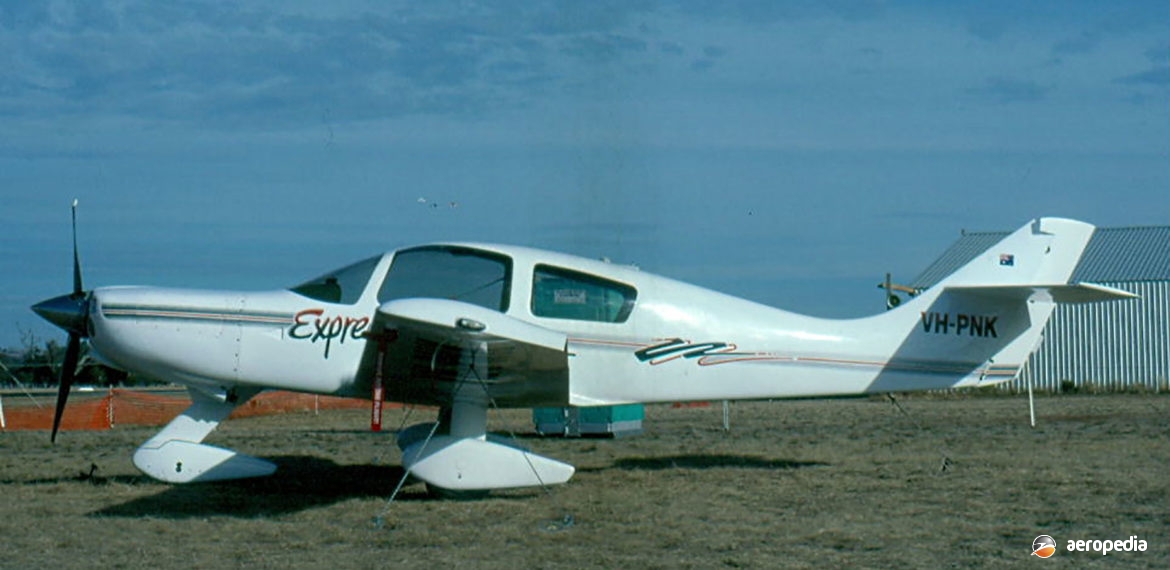Photograph:
Express Aircraft Express VH-PNK (c/n Q119) at Mangalore, VIC in April 1998 (David C Eyre)
Country of origin:
United States of America
Description:
Four-seat cabin monoplane
Power Plant:
One 186 kw (250 hp) Lycoming IO-540-C4B5 six-cylinder horizontally-opposed air-cooled engine
Specifications:
- Wingspan: 9.6 m (31 ft 5 in)
- Length: 7.92 m (26 ft)
- Height: 2.13 m (7 ft)
- Wing area: 12.07 m² (130 sq ft)
- Max speed: 426 km/h (265 mph)
- Max cruising speed: 322 km/h (200 mph)
- Rate of climb: 488 m/min (1,600 ft/min)
- Stalling speed flaps and gear down: 80 km/h (50 mph)
- Service ceiling: 6,096 m (20,000 ft)
- Range: 2,575 km (1,600 miles)
- Empty weight: 748 kg (1,650 lb)
- Loaded weight: 1,313 kg (2,895 lb)
History:
The Express Aircraft Express was designed and developed by Wheeler Technology as a high-speed cross-country kitplane, with the unusual seating featuring one forward and one aft-facing seat in the rear, behind two side-by-side front seats with dual controls. Three prototypes were built, the first making its initial flight on 28 July 1987. A pre-production aircraft, which was slightly larger, was flown in May 1990 fitted with a Teledyne Continental engine. However, the company went into liquidation before production aircraft were delivered.
In 1991 Ralph Kinner acquired the assets of Wheeler Technology, but later sold them to David Ullrich of Redmond, Oregon, who set up a company known as Express Designs Inc to develop and sell the type in kit form. The Express then became available in three forms, the Express FT with a 149 kw (200 hp) Lycoming IO-360 engine; the Express RG Moriagh with a 224 kw (300 hp) Continental IO-550 engine, subsequently known as the Express 90; and the Express Loadmaster 3200 with a 194 kw (260 hp) Lycoming IO-540 engine, the Loadmaster seating six. Variants with fixed and retractable undercarriages were available; and one model, the RG Express, was fitted with a 261 kw (350 hp) Continental TSIO-550E twin-turbocharged engine driving a three-blade Hartzell constant-speed propeller.
The Express had two control sticks, a door on each side, and was of all-composite construction. The Express 2000, in production, was the most popular model, with more than 300 kits delivered by Express Aircraft Company. Construction was of composite sandwich material, comprising polyurethane foam core, fibreglass, uni-directional fibreglass tape and vinylester resin. The non-retractable tricycle type undercarriage was standard but a retractable undercarriage was optional. Fuel capacity was normally 204 litres (45 Imp gals), but optional tanks could be fitted providing 348 litres (76.6 Imp gals) of fuel. One aircraft was built with a 209 kw (280 hp) Continental IO-550 engine in tailwheel configuration.
First of the type in this region was VH-PNK (c/n Q119), registered as a Wheeler Express 260, which was demonstrated at the Sports Aircraft Association of Australia (SAAA) fly-in at Mangalore, VIC in April 1998.
Development of the series continued, Express Aircraft Company announcing in early 2001 the first builder-assist / factory-finished Express Series 2000 aircraft had been completed. To meet the 51 per cent rule, the owner built the entire airframe using the manufacturer’s six-week builder-assist program.

